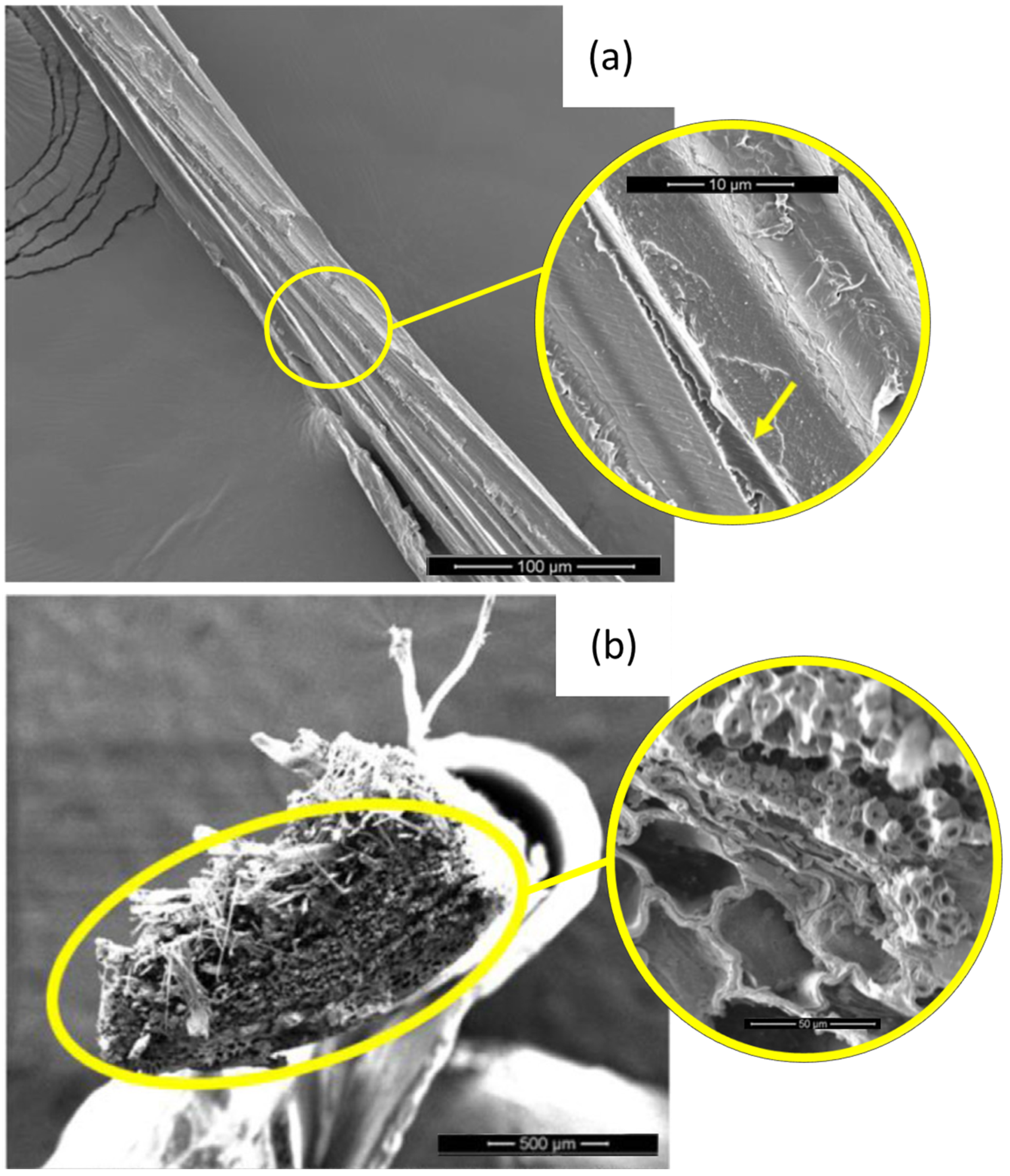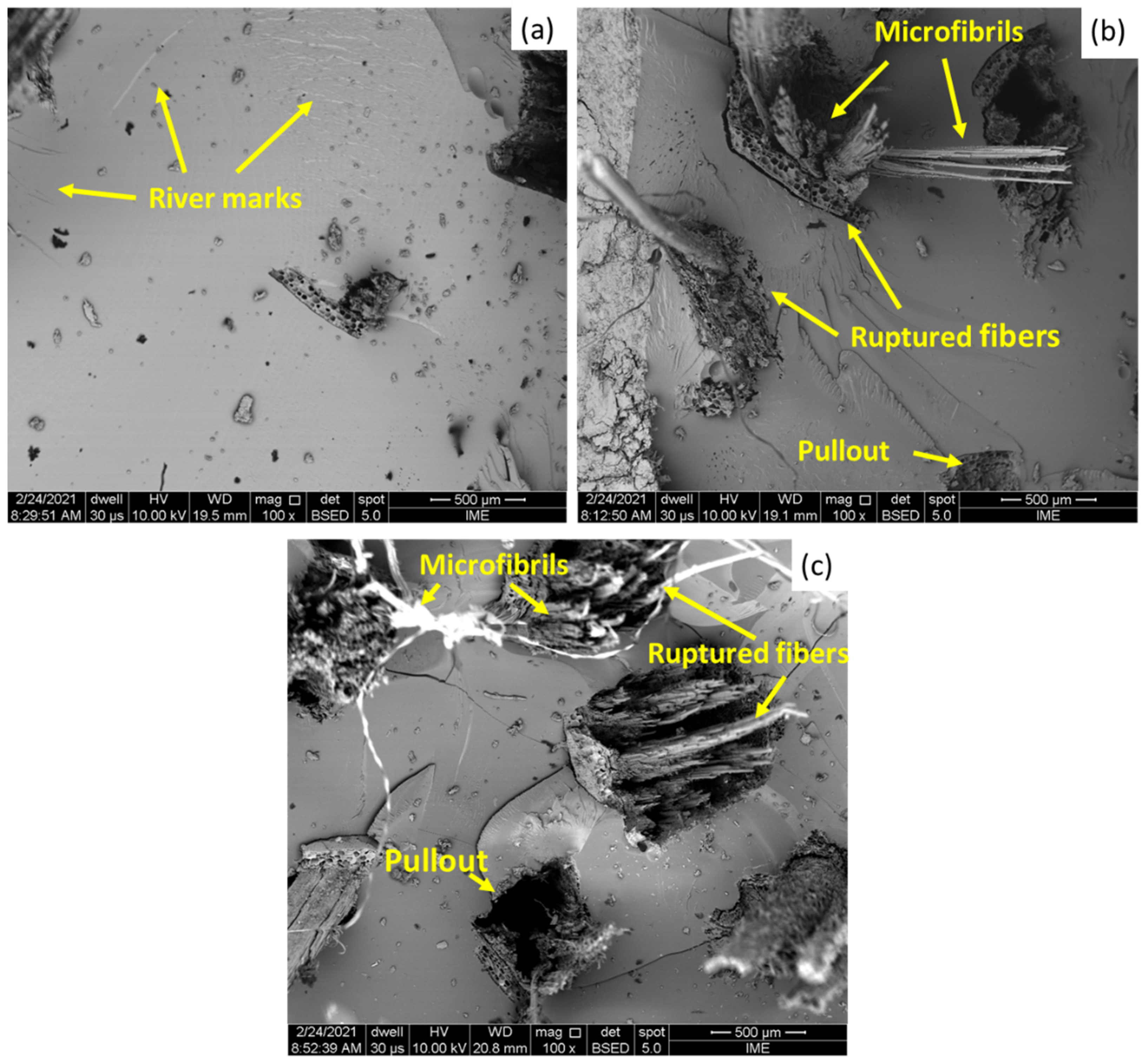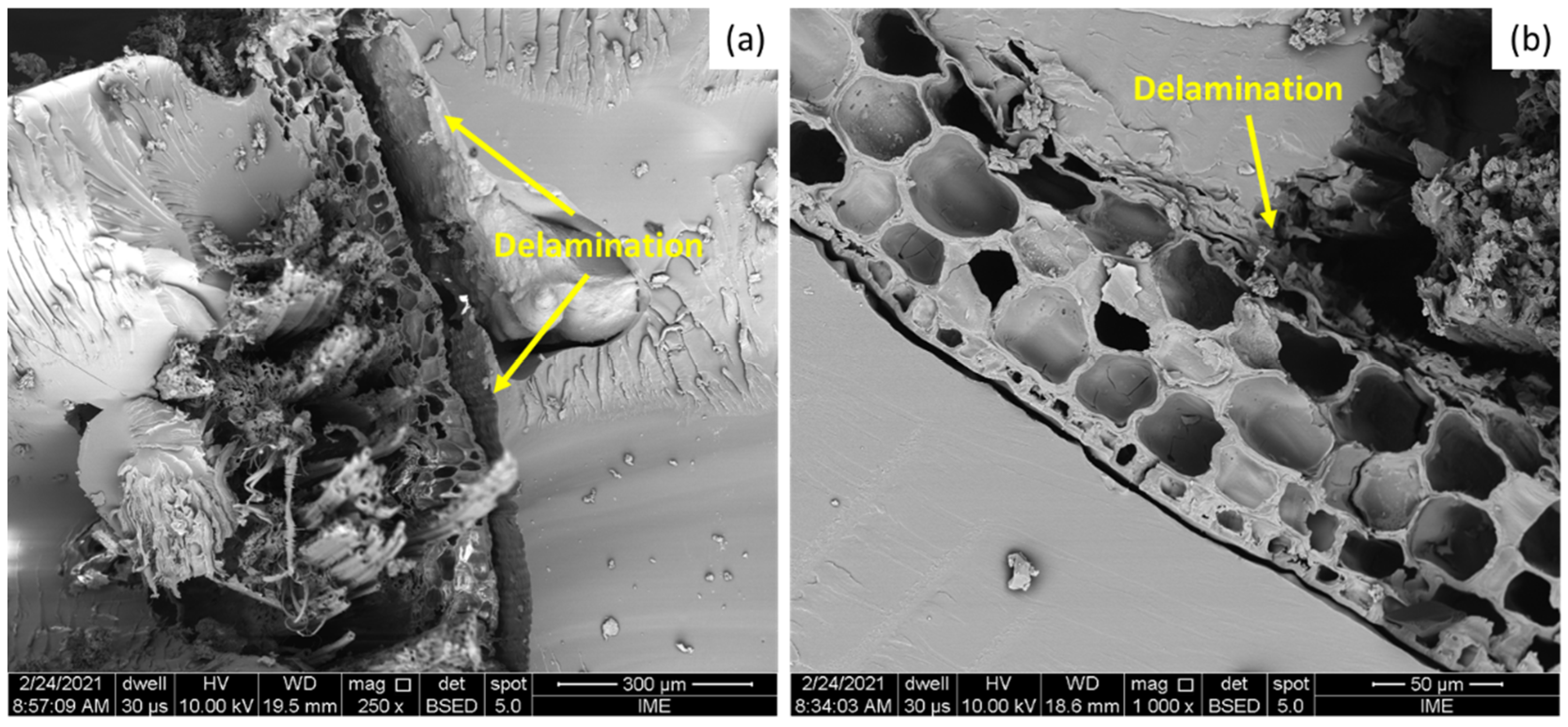Impact Resistance of Epoxy Composites Reinforced with Amazon Guaruman Fiber: A Brief Report
Abstract
:1. Introduction
2. Materials and Methods
2.1. Materials
2.2. Composite Processing
2.3. Izod Impact Test
2.4. Statistical Validation
2.5. Scanning Electron Microscopy (SEM)
3. Results
3.1. Impact Resistance
3.2. Statistical Validation
3.3. Scanning Electron Microscopy Analysis
3.4. Comparison to Other NLFs Reinforcing Epoxy Composites
4. Conclusions
- The incremental increase in the volume fraction of fiber reinforcement resulted in an increase in the impact resistance of the composite. Composites reinforced with 30 vol% of guaruman fiber exhibited an improvement of over 20 times in terms of impact energy absorption in comparison to a neat epoxy condition. The measured results were validated with 95% confidence by Weibull analysis, ANOVA, and Tukey’s statistical test.
- A shift was observed in the main failure mechanisms of the composites’ energy absorption. The composite with the lowest amount of reinforcement (10 vol%) exhibited brittle characteristics, while higher amounts of reinforcement (20 and 30 vol%) resulted in a combination of complex mechanisms, such as fracture of fibers, pullout, and delamination, which are proposed to be directly associated with the high impact energy absorption by these composites.
- The results obtained with 30 vol% reinforcement with guaruman fiber were compared with other NLFs reinforcing epoxy matrix composites. The reinforcement guaranteed by the guaruman fiber was one of the highest ever reported for NLF composites. The low density exhibited by the guaruman fiber directly impacts on the specific properties of this kind of composite. This combination of high impact resistance and low density is desirable in many applications, such as ballistics, as well as in the vehicular and aerospace industries.
Author Contributions
Funding
Institutional Review Board Statement
Informed Consent Statement
Data Availability Statement
Acknowledgments
Conflicts of Interest
References
- Bledzki, A.K.; Gassam, J. Composites reinforced with cellulose based fibers. Prog. Polym. Sci. 1999, 24, 221–274. [Google Scholar] [CrossRef]
- Thakur, V.; Thakur, M.K.; Gupta, R.K. Review: Raw natural fiber-based polymer composites. Int. J. Polym. Anal. Charact. 2014, 19, 256–271. [Google Scholar] [CrossRef]
- Sanjay, M.; Madhu, P.; Jawaid, M.; Senthamaraikannan, P.; Senthil, S.; Pradeep, S. Characterization and properties of natural fiber polymer composites: A comprehensive review. J. Clean. Prod. 2018, 172, 566–581. [Google Scholar] [CrossRef]
- Garcia Filho, F.C.; Luz, F.S.; Oliveira, M.S.; Pereira, A.C.; Costa, U.O.; Monteiro, S.N. Thermal behavior of graphene oxide-coated piassava fiber and their epoxy composites. J. Mater. Res. Technol. 2020, 9, 5343–5351. [Google Scholar] [CrossRef]
- Garcia Filho, F.C.; Luz, F.S.; Nascimento, L.F.C.; Satyanarayana, K.G.; Drelich, J.W.; Monteiro, S.N. Mechanical Properties of Boehmeria nivea natural fabric reinforced epoxy matrix composite prepared by vacuum-assisted resin infusion molding. Polymers 2020, 12, 1311. [Google Scholar] [CrossRef] [PubMed]
- Zhang, Z.; Cai, S.; Li, Y.; Wang, Z.; Long, Y.; Yu, T.; Shen, Y. High performance of plant fiber reinforced composites–A new insight from hierarchical microstructures. Compos. Sci. Technol. 2020, 194, 108151. [Google Scholar] [CrossRef]
- Kalia, S.; Kaith, B.S.; Kaur, I. Cellulose Fibers: Bio- and Nano-Polymer Composites, 1st ed.; Springer: New York, NY, USA, 2011. [Google Scholar] [CrossRef]
- Luz, F.S.; Garcia Filho, F.C.; del-Rio, M.T.G.; Nascimento, L.F.C.; Pinheiro, W.A.; Monteiro, S.N. Graphene-incorporated natural fiber polymer composites: A first overview. Polymers 2020, 12, 1601. [Google Scholar] [CrossRef]
- Dunne, R.; Desai, D.; Sadiku, R.; Jayaramudu, J. A review of natural fibres, their sustainability and automotive applications. J. Reinf. Plast. Compos. 2016, 35, 1041–1050. [Google Scholar] [CrossRef]
- Potluri, R.; Krishna, N.C. Potential and Applications of Green Composites in Industrial Space. Mater. Today Proc. 2020, 22, 2041–2048. [Google Scholar] [CrossRef]
- Mansor, M.R.; Nurfaizey, A.H.; Tamaldin, N.; Nordin, M.N.A. Natural fiber polymer composites: Utilization in aerospace engineering. Biomass Biopolym. Based Mater. Bioenergy 2019, 203–224. [Google Scholar] [CrossRef]
- Youssef, A.M.; El-Sayed, M. Bionanocomposites materials for food packing applications: Concepts and future outlook. Carbohydr. Polym. 2018, 193, 19–27. [Google Scholar] [CrossRef]
- Krishna, N.K.; Prasanth, M.; Gowtham, R.; Karthic, S.; Madhavan, M.K. Enhancement of properties of concrete using natural fibers. Mater. Today Proc. 2018, 5, 23816–23823. [Google Scholar] [CrossRef]
- Barbosa, J.D.V.; Azevedo, J.B.; Silva, M.C.P.; Filho, F.C.G.; del-Rio, T.G. Development and characterization of WPCs produced with high amount of wood residue. J. Mater. Res. Technol. 2020, 9, 9684–9690. [Google Scholar] [CrossRef]
- Silva, G.; Kim, S.; Aguilar, R.; Nakamatsu, J. Natural fibers reinforcement additives for geopolymers—A review of potential eco-friendly applications to the construction industry. Sustain. Mater. Technol. 2020, 23, e00132. [Google Scholar] [CrossRef]
- Luz, F.S.; Garcia Filho, F.C.; Oliveira, M.S.; Nascimento, L.F.C.; Monteiro, S.N. Composites with natural fibers and conventional materials Applied in a hard armor: A comparison. Polymers 2020, 12, 1920. [Google Scholar] [CrossRef]
- Pereira, A.C.; Assis, F.S.; Garcia Filho, F.C.; Oliveira, M.S.; Lima, E.S.; Lopera, H.A.C.; Monteiro, S.N. Evaluation of the projectile’s loss of energy in polyester composite reinforced with fique fiber and fabric. Mater. Res. 2019, 22. [Google Scholar] [CrossRef]
- Garcia Filho, F.C.; Oliveira, M.S.; Pereira, A.C.; Nascimento, L.F.C.; Matheus, J.R.G.; Monteiro, S.N. Ballistic behavior of epoxy matrix composites reinforced with piassava fiber against high energy ammunition. J. Mater. Res. Technol. 2020, 9, 1734–1741. [Google Scholar] [CrossRef]
- Nurazzi, N.M.; Asyraf, M.R.M.; Khalina, A.; Abdullah, N.; Aisyah, H.A.; Rafiqah, S.A.; Sabaruddin, F.A.; Kamarudin, S.H.; Norrrahim, M.N.F.; Ilyas, R.A.; et al. A Review on Natural Fiber Reinforced Polymer Composite for Bullet Proof and Ballistic Applications. Polymers 2021, 13, 646. [Google Scholar] [CrossRef]
- Nayak, S.Y.; Sultan, M.T.H.; Shenoy, S.B.; Kini, C.R.; Samant, R.; Shah, A.U.M.; Amuthakkannan, P. Potential of natural fibers in composites for ballistic applications—A review. J. Nat. Fibers 2020. [Google Scholar] [CrossRef]
- Pinheiro, M.A.; Gomes, L.G.; Silva, A.C.R.; Candido, V.S.; Reis, R.H.M.; Monteiro, S.N. Guaruman: A natural Amazonian fiber with potential for Polymer composite reinforcement. Mater. Res. 2019, 22, 20190092. [Google Scholar] [CrossRef] [Green Version]
- Reis, R.H.M.; Nunes, L.F.; Oliveira, M.S.; Veiga Junior, V.F.; Garcia Filho, F.C.; Pinheiro, M.A.; Silva, A.C.R.; Candido, V.S.; Monteiro, S.N. Guaruman fiber: Another possible reinforcement in composites. J. Mater. Res. Technol. 2020, 9, 622–628. [Google Scholar] [CrossRef]
- Reis, R.H.M.; Nunes, L.F.; Luz, F.S.; Candido, V.S.; Silva, A.C.R.; Monteiro, S.N. Ballistic performance of guaruman fiber composites in multilayered armor system and single target. Polymers 2021, 13, 1203. [Google Scholar] [CrossRef]
- Global Biodiversity Information Facility. Available online: https://www.gbif.org/pt/ (accessed on 10 June 2021).
- Neuba, L.M.; Junio, R.F.P.; Ribeiro, M.P.; Souza, A.T.; Lima, E.S.; Garcia Filho, F.C.; Figueiredo, A.B.H.S.; Braga, F.O.; Azevedo, A.R.G.; Monteiro, S.N. Promising mechanical, thermal, and ballistic properties of novel epoxy composites reinforced with Cyperus malaccesis sedge fiber. Polymers 2020, 12, 1776. [Google Scholar] [CrossRef]
- Junio, R.F.P.; Nascimento, L.F.C.; Neuba, L.M.; Souza, A.T.; Moura, J.V.B.; Garcia Filho, F.C.; Monteiro, S.N. Copernicia prunifera leaf fiber: A promising new reinforcement for epoxy composites. Polymers 2020, 12, 2090. [Google Scholar] [CrossRef] [PubMed]
- Oliveira, M.S.; Garcia Filho, F.C.; Luz, F.S.; Pereira, A.C.; Demosthenes, L.C.C.; Nascimento, L.F.C.; Lopera, H.A.C.; Monteiro, S.N. Statistical analysis of notch toughness of epoxy matrix composites reinforced with fique fabric. J. Mater. Res. Technol. 2019, 8, 6051–6057. [Google Scholar] [CrossRef]
- Oliveira, M.S.; Luz, F.S.; Souza, A.T.; Demosthenes, L.C.C.; Pereira, A.C.; Garcia Filho, F.C.; Braga, F.O.; Figueiredo, A.B.H.S.; Monteiro, S.N. Tucum fiber from Amazon Astrocaryum vulgare palm tree: Novel reinforcement for polymer composites. Polymers 2020, 12, 2259. [Google Scholar] [CrossRef]
- Costa, U.O.; Nascimento, L.F.C.; Garcia, J.M.; Bezerra, W.B.A.; Monteiro, S.N. Evaluation of Izod impact and bend properties of epoxy composites reinforced with mallow fibers. J. Mater. Res. Technol. 2020, 9, 373–382. [Google Scholar] [CrossRef]
- Mishra, V.; Biswas, S. Physical and Mechanical Properties of Bi-directional Jute Fiber Epoxy Composites. Procedia Eng. 2013, 51, 561–566. [Google Scholar] [CrossRef] [Green Version]
- Ribeiro, M.P.; Neuba, L.M.; Silveira, P.H.P.M.; Luz, F.S.; Figueiredo, A.B.H.S.; Monteiro, S.N.; Moreira, M.O. Mechanical, termal and ballistic performance of epoxy composites reinforced with Cannabis sativa hemp fabric. J. Mater. Res. Technol. 2021, 12, 221–233. [Google Scholar] [CrossRef]






| Epoxy Composite | 10 vol% Guaruman | 20 vol% Guaruman | 30 vol% Guaruman |
|---|---|---|---|
| Eabsorbed (J/m) | 144.37 | 257.21 | 375.01 |
| Standard deviation | 57.96 | 53.09 | 96.96 |
| β | 2.89 | 5.27 | 4.30 |
| θ | 161.87 | 279.12 | 411.73 |
| R2 | 0.95 | 0.93 | 0.96 |
| Variation Causes | DF | SS | MS | Fcalc | Fcritical (tab.) |
|---|---|---|---|---|---|
| Treatment | 2 | 481,813.59 | 240,906.80 | 41.03 | 3.18 |
| Residue | 51 | 299,463.80 | 5871.84 | ||
| Total | 53 | 781,277.39 |
| Epoxy Composites with GF Reinforcement | GF10 vol% | GF20 vol% | GF30 vol% |
|---|---|---|---|
| GF10 vol% | 0.00 | 114.45 | 231.37 |
| GF20 vol% | 114.45 | 0.00 | 116.92 |
| Gf30 vol% | 231.37 | 116.92 | 0.00 |
| Fiber Reinforcement | Average Absorbed Energy (J/m) | Fiber Density (g/cm3) | Specific Absorbed Energy (J/m per g/cm3) | Reference |
|---|---|---|---|---|
| Guaruman (Ischinosiphon körn) | 477 | 0.57 | 506.91 | PW |
| Ramie (Boehmeria nivea) | 567 | 1.5 | 464.75 | [5] |
| Sedge (Cyperus malaccensis) | 63 | 0.46 | 69.38 | [25] |
| Carnauba (Copernicia prunifera) | 137 | 1.34 | 116.89 | [26] |
| Fique (Furcraea andina) | 134 | 0.67 | 138.00 | [27] |
| Tucum (Astrocaryum vulgare) | 166 | 1.61 | 132.48 | [28] |
| Mallow (Urena lobata) | 499 | 1.00 | 466.35 | [29] |
| Jute (Corchorus capsularis) | 426 | 1.44 | 354.41 | [30] |
| Hemp (Cannabis sativa) | 134 | 1.52 | 109.29 | [31] |
Publisher’s Note: MDPI stays neutral with regard to jurisdictional claims in published maps and institutional affiliations. |
© 2021 by the authors. Licensee MDPI, Basel, Switzerland. This article is an open access article distributed under the terms and conditions of the Creative Commons Attribution (CC BY) license (https://creativecommons.org/licenses/by/4.0/).
Share and Cite
Reis, R.H.M.; Garcia Filho, F.C.; Nunes, L.F.; Candido, V.S.; Silva, A.C.R.; Monteiro, S.N. Impact Resistance of Epoxy Composites Reinforced with Amazon Guaruman Fiber: A Brief Report. Polymers 2021, 13, 2264. https://doi.org/10.3390/polym13142264
Reis RHM, Garcia Filho FC, Nunes LF, Candido VS, Silva ACR, Monteiro SN. Impact Resistance of Epoxy Composites Reinforced with Amazon Guaruman Fiber: A Brief Report. Polymers. 2021; 13(14):2264. https://doi.org/10.3390/polym13142264
Chicago/Turabian StyleReis, Raphael H. M., Fabio C. Garcia Filho, Larissa F. Nunes, Veronica S. Candido, Alisson C. R. Silva, and Sergio N. Monteiro. 2021. "Impact Resistance of Epoxy Composites Reinforced with Amazon Guaruman Fiber: A Brief Report" Polymers 13, no. 14: 2264. https://doi.org/10.3390/polym13142264
APA StyleReis, R. H. M., Garcia Filho, F. C., Nunes, L. F., Candido, V. S., Silva, A. C. R., & Monteiro, S. N. (2021). Impact Resistance of Epoxy Composites Reinforced with Amazon Guaruman Fiber: A Brief Report. Polymers, 13(14), 2264. https://doi.org/10.3390/polym13142264








